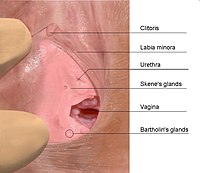
Photo from wikipedia
Physiological responses during a standardized treadmill test for structural firefighting employment were compared in 41 pairs of size-matched, male and female applicants. Applicants wore personal clothing, running shoes, and fire… Click to show full abstract
Physiological responses during a standardized treadmill test for structural firefighting employment were compared in 41 pairs of size-matched, male and female applicants. Applicants wore personal clothing, running shoes, and fire protective ensemble with self-contained breathing apparatus (added mass 21.2 ± 1.0 kg). Applicants walked at 1.56 m.s-1, completing a 5-min warm-up, 8-min at 10% grade and then, progressive, 1-min stages to exhaustion. The cut-score required completion of 13-min of exercise. Up to the cut-score, no differences in heart rate, oxygen uptake or minute ventilation were detected between sexes. At time 12:30-13:00 min, V̇O2 was 45.7 ± 0.6 vs. 44.2 ± 0.5 mL.kg-1.min-1 (body mass) for males and females, respectively. Despite similar physiological responses at minute 13, females worked at higher fractions of peak than males (p < 0.05). A second analysis compared a subset of 27 fitness-matched (V̇O2peak) male-female pairs. Fitness-matching further reduced or eliminated most observed differences in physiological responses, except small differences in breathing pattern.
Journal Title: Ergonomics
Year Published: 2022
Link to full text (if available)
Share on Social Media: Sign Up to like & get
recommendations!